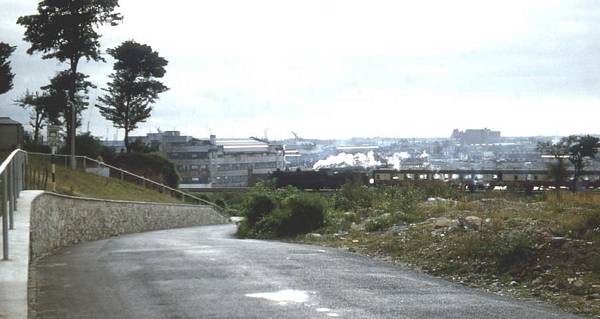| Pakolor at United D&P Services, Southampton |
|
|
|
|
| David Goodall has written (2007) to tell me of his recollections working for two years in a laboratory in Southampton that processed and printed Pakolor film. He started straight from school, aged 16 in 1954, and carried out Pakolor (and monochrome) print processing for two years until he was 18 and was 'called up' for National Service. The laboratory was to the west of Southampton based at the Eucryl Tooth Paste factory site and went under the company name of United D&P Services. Its address was Eucryl Colour Film Laboratories, Oakley Road, Shirley, Southampton. United D&P were an independant service but took on Pakolor processing & printing as an extra service. | |||
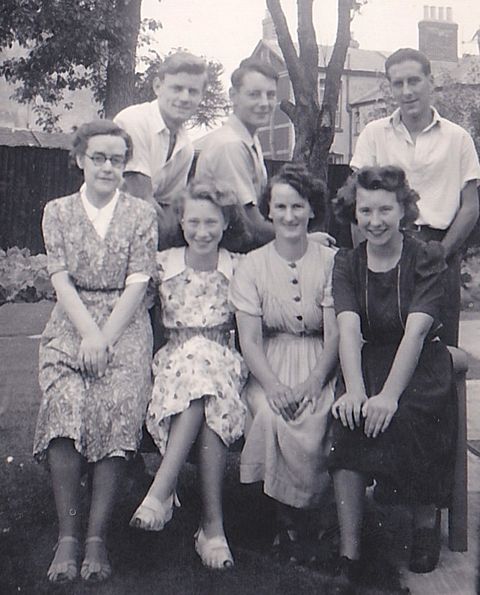 |
More recently (2014), Joseph Paglia has sent me the group photograph alongside. He says: "It's my Aunt Ethel (Irene Agnes) Sennatt (with Glasses), who worked at the (Eucryl) Laboratory; I believe she was a manager. This photo' I would guess would be her with other employees, perhaps her team". Ethel Sennatt was born 11/09/1908, "so judging her age in the photo' would place the date taken as sometime in the 1950s". The chances are that David Goodall would have known Ethel, as she would have been at the Eucryl laboratory around much the same time that David was (between 1954 and 1956). I've recently tried to contact David to ask if he recalls Ethel (he might even be in this photograph), but he has not replied, so perhaps has changed his email address. If you read this David, do get back in touch with me. |
||
|
There were four other laboratories in the country doing Pakolor printing; Caithness (Color Photos) Ltd, Kirkaldy, Fifeshire; Millscolor, Saddler Street, Durham, J.P.Roche & Co.Ltd, Lower O'Connell Street, Dublin and Wallis, Lindrum Ltd; 7a Buckingham Palace Road, London, S.W.1. David cycled to and from work, some 5 miles each way, from the Sholing district in the east of Southampton, across the city centre to Shirley. In his journey he had to cross the River Itchen, using the 'chain ferry' known locally as 'the floating bridge'. Having crossed the river, David recalls the "long drag up to Shirley, all uphill !" |
|||
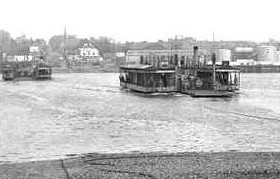 |
 |
The 'chain ferry' floating bridge across the River Itchen consisted of large barges, capable of carrying several motor vehicles as well as passengers. Opened 23rd November 1836, the barges were steam powered using (coal fired ?) boilers. Chains were laid across the river bed and machinery on each 'floating bridge' barge used the chains to pull itself across the Itchen. The installation survived for 141 years until the new toll bridge was opened 1st June 1977. | |
| The b&w pictures shown above are by courtesy of Tony Seaton. Visit Tony's site and see more pictures, some by L S Lowry, and also a wonderful You-Tube 'movie' with folk music accompaniment. | |||
|
|
|
March 2007 when I visited Southampton; alongside are some of my own pictures. The extreme left picture is a view looking east across the River Itchen near the Toll Bridge. The gates of the Southampton Water Activities Centre guard the western slip way of the old floating bridge chain ferry. A section of chain on a sprocket wheel can be seen near the eastern slip way at Spitfire Quay, Hazel Rd. Unfortunately, there is no plaque to explain to visitors the reason for this unusual 'exhibit' and the other historic aspect of this part of Southampton.. |
|
|
The name Spitfire Quay in the above picture, and the use of the name Mitchell Close for the nearby road serving a new, small, housing development, is due to the area being the 'home' of the historic WW2 fighter plane named the 'Spitfire', developed by R.J.Mitchell. David Goodall has sent me the
picture (left) of The Supermarine Aviation Works (Vickers) Ltd.,
Hazel Road, where R.J.Mitchell designed the Spitfire during the
mid-1930s; though David admits he probably took the shot because
of the steam train running from Bittern to Woolston. |
||
|
David applied to United D&P Services to be a trainee laboratory technician and his first job, after very little training, was to process Pakolor colour prints. This entailed putting the exposed paper into plastic cages attached to a plastic frame, each frame having a mixture of different size containers catering for different size prints. This was done in almost total darkness, the safelight being very dense. There was a home made electric timer with a big face, painted white with luminous paint on the hands. The minutes and seconds painted on the face were also luminous. David could then see this well enough to move the baskets of prints suspended on rods into the solutions at the right time. The processing was done in
ex-submarine battery tanks because they had the required depth
(around 50"). In their original use, such tanks provided
an acid-proof enclosure against battery electrolyte leakage.
Since electrolyte is highly corrosive sulphuric acid, leakage
could seriously weaken the pressure hull of a submarine if it
went undetected. Film processing was done in an adjacent wet room by a colleague and followed almost the same procedure as the print processing. This colleague, with David's assistance, also mixed the bulk powder chemicals, supplied whole sale from various sources. The resulting negatives were assessed for filtration and exposure in a daylight part of the lab, remote from the printing and processing area. This was done by a colleague named Chris White but occasionally, when problems arose, a Dr Jacobson visited from head office (in the mid-1950s Head Office would have been Associated British Pathe Ltd, Pathe House, Oxford St; London). David recalls Dr Jacobson visiting to try and solve a problem of the white borders of the prints becoming discoloured during processing. After much scratching of heads and testing it was discoverd that the string threaded through the bottom of the print processing containers were becoming contaminated with the chemicals and contaminating the developer ! David also recalls United D&P having a duff batch of paper which was so biased to cyan that, no matter how you tried to correct it, you could not get a decent print. It must have been badly coated. Both contact prints (from roll film negatives) and enlargements, 'en-prints', were available. Prices were 2/9d & 5/6d each respectively (14p & 28p) and quality was quite good for the time. Contact prints were produced using modified treadle operated contact printers working on the subtractive filtration process, while the en-print enlargements were made using conventional enlargers fitted with a turret beneath the lens with additive red, green and blue filters. There was also a correction filter built in beneath the light source. The power supply was stabilised from the mains. |
|||
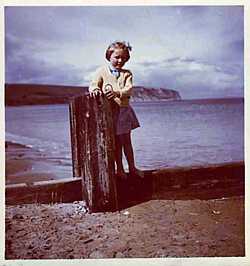 |
David's wages in those days were only 2 pounds 10 shillings per week (£2.50p) so David couldn't afford to use much Pakolor himself, but he has one contact print, of his sister. The blue version (left) is a 'straight' scan and the other is believed nearer to what the print should have looked like if correctly colour balanced. |
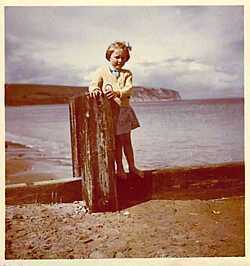 |
|
| In David's last few months working at United D&P, Pakolor processing ended after Kodak UK announced the Kodak S.1, their first Automatic colour printing machine (600 prints / hour). | |||
| Subsequently, Kodak began to dominate the colour D&P market, both with speed and price. Initially (from 1957), Kodak UK kept control of their printing machines, chemicals and materials, and offered colour printing through photo' dealers. However, by 1959 they started to supply similar to the photofinishing trade and these became commercial in time to satisfy the summer 1960 demand. | |||
| Pakolor bought out their own semi-automatic 'Rollhead' colour printer (reviewed in BJPA for 1959), but presumably this did not adequately compete with the Kodak offering. |
|
||
|
David Goodall recalls that Kodacolor was a masked negative film, so the colour was so much better than Pakolor materials could provide. Fortunately United D&P thought David was worth retaining on the staff and so, together with an older employee, he dismantled the Pakolor equipment and was then transferred to the monochrome print enlarging room, where he finished his employment prior to being 'called up' for National Service*. Whilst working at United D&P David found all his fellow employees to be very friendly towards a young man in his first job. Probably as a consequence of Kodak's film and automatic print processors taking over much of the UK colour print market from 1957, it seems that it wasn't just United D&P who stopped offering a Pakolor d&p service. By 1959, Pakolor film processing and printing had become the domain of a company called 'Photo Synthetics Ltd' located at 15 College Road, Epsom, Surrey, UK. Since this address is not far from what was the 'home' of Pakolor, at Church Road, Epsom, Surrey, there may have been a commercial link between the two. |
|||
| After National Service, David worked for a few years in commercial and wedding photography in both Chichester and Petersfield before becoming a local agent for a large insurance company. Then, aged 55 and with early retirment, he obtained a part time job with a local photographic shop and is still working there (2005). He has kept abreast of the technical advances and has been using a PC for approximately 10 years. For most of his photographic work he uses slide film but scans the slides to make prints for the local camera club competitions, where he is currently into his 3rd year as president of the club. | |||
* For almost two decades after WW2, the UK required young men to undergo 2 years of National Service. Between 1945 and the end of 1962, 2.5 million young men were compelled to do their time in National Service - with 6,000 being called up every fortnight. The last call-up was in 1960 and the last of those called-up came out of the forces in 1962. By the end of 1962 the aim was for an all-regular force totalling some 375,000 men. |
|||
|
|
|
|
|
|
||
